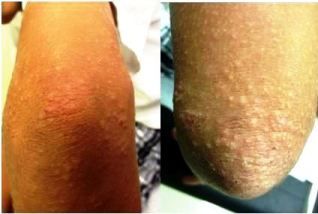- Clinical Technology
- Adult Immunization
- Hepatology
- Pediatric Immunization
- Screening
- Psychiatry
- Allergy
- Women's Health
- Cardiology
- Pediatrics
- Dermatology
- Endocrinology
- Pain Management
- Gastroenterology
- Infectious Disease
- Obesity Medicine
- Rheumatology
- Nephrology
- Neurology
- Pulmonology
Scabies: Timely Diagnosis Key to Containment, Relief
A scabies diagnosis can be made with a history of pruritus that is worse in the evening with a rash in a typical distribution and a history of itching in close contacts.

A 9-year-old boy presented with a 1-week history of pruritus and rash on his elbows, knees (Figure), back, and legs. He described the rash as itching to the point of waking him from sleep, and several areas of excoriation were noted. He had recently run through a field of tall grass but denied any other exposure history. He played in an after-school football league and the family has 1 dog in the home that has been with them for many years and has no evidence of infection or infestation. The review of systems was otherwise negative, and the patient was sent home with a brief course of oral prednisone.
He returned 4 days later with worsening symptoms.
Given the history of present illness and the images above, what is the most likely diagnosis?
The correct answer is A: Scabies.
Discussion
The diagnosis of scabies can be made with a history of pruritus that is worse in the evening with a rash in a typical distribution and a history of itching in close contacts.1 The burrow is the classic sign of scabies and the skin lesions have a predilection for the interdigital web spaces of hands, flexor surfaces of wrists, extensor surfaces of elbows, extensor surfaces of knees, periumbilical skin, axillae, genitalia, and the periareolar region in females.1
The dermatologic manifestation is recognized as a pruritic, papular rash with a characteristic pattern of excoriations.2 Definitive diagnosis relies on the identification of mites, eggs, eggshell fragments, or mite pellets as well as visualization of burrows.3 Despite heavy use over the past 2 decades, there is no clear evidence of resistance to permethrin 5% cream, and it remains the first-line treatment.4 Patient education is critical for successful treatment. Permethrin cream should be applied to all areas of the body from the neck down, kept on for 8 to 14 hours, washed off, and reapplied in the same fashion 1 week later.4 Environmental control measures for scabies include washing sheets and clothing at 60°C (140°F) and drying in a hot dryer.4
When the patient returned 4 days after initial presentation with worsening symptoms, it was discovered through further questioning that he had shared football pads with a teammate who also had been experiencing an intensely itchy rash, which underscores the importance of obtaining a thorough exposure history for dermatologic complaints-particularly in pediatric patients. Delayed diagnosis of mite infestation can lead to delayed treatment, severe emotional disturbance, symptom persistence, and the spread of the infection to other close contacts.1
Here, a brief review of the other dermatoses in the differential diagnosis.
B. Atopic dermatitis is an acute, subacute, or chronic relapsing skin disorder that usually begins in infancy and is characterized by dry skin and pruritus and leads to increased inflammation and lichenification.5 Predilection is seen for the flexures, front and sides of the neck, eyelids, forehead, face, wrists, and dorsa of the feet and hands.5 Commonly known as the “itch that rashes,” failure to resolve with corticosteroid treatment suggests an alternative diagnosis.
C. Guttate psoriasis is a form of psoriasis most commonly affecting persons younger than 30 years with characteristic lesions that are small, salmon-pink, and scaly that present on the arms, legs, and trunk.5 Lesions may resolve spontaneously within a few weeks but usually become recurrent and may evolve into chronic, stable psoriasis.5 Psoriasis does not respond to permethrin.
D. Nummular eczema is a chronic, relatively uncommon allergic reaction in the elderly. It is more commonly found during winter months and is characterized by pruritic, coin-shaped spots or patches typically found on the arms and legs.5 It is commonly found in individuals with allergic rhinitis, atopy, or asthma. While the cause is unknown, it is thought to be exacerbated by environmental irritants, temperature changes, and dry skin.5
E. Folliculitis is an infection of the hair follicles that causes mild itching or tenderness and erythematous papules or pustules commonly found on the neck, chest, back, buttock, and thighs. Elbows are not a common location for folliculitis.5References:
1. Golant AK, Levitt JO. Scabies: a review of diagnosis and management based on mite biology. Pediatr Rev. 2012;33:e1-e12. doi:10.1542/pir.33-1-e1. (Abstract)
2. Gunning K, Pippitt K, Kiraly B, Sayler M. Pediculosis and scabies: treatment update. Am Fam Physician. 2012;86:535-541. (Abstract)
3. Chosidow O. Clincal practices: scabies. N Engl J Med. 2006;354:1718-1727. (Full text)
4. Scabies fact sheet. Atlanta: Centers for Disease Control and Prevention; 2010. Accessed July 7, 2013. http://www.cdc.gov/parasites/scabies/index.html.
5. Wolff K, Johnson RA. Fitzpatrick’s Color Atlas & Synopsis of Clinical Dermatology. 6th ed. New York: The McGraw-Hill Companies, Inc; 2009:34-868.
